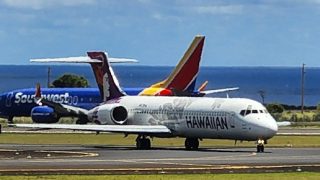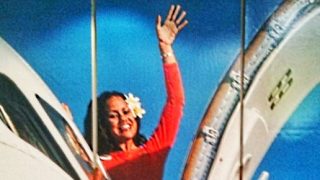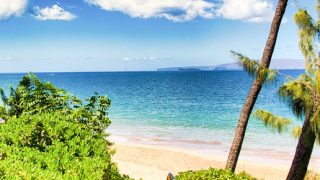It was bound to happen, and after five long years for both airlines, it has begun. The first few years of Southwest’s entry into Hawaii seemed like a non-stop, free-wheeling price war. Fares dropped to as little as $29 for interisland flights, and $39 soon became the standard fare. From the mainland, $99 became the popular number for airfares from the most competitive west coast cities of San Diego, Los Angeles, San Jose, and Oakland to all the Hawaiian Islands. It has returned to $119, but will probably not stay there for much longer.
All good things come to an end. And some cheap Hawaii airfares were just too good to be true.
It isn’t immediately apparent that prices have increased as much as they have, but here’s how it works in practice. BOH editors are on a tear covering the islands, including the Big Island last week, Honolulu this week, followed by Maui next. We have bought tickets for many trips between now and December. And while we still see $44 tickets, we couldn’t find them most times when we wanted to travel. The new number we are paying is what we consider to be a more realistic price of $74. Sure, we loved the $39 airfares, and the $29 ones too, for that matter, but we realize that those aren’t sustainable prices – they are far less than what it costs the airlines, both Hawaiian and Southwest, to offer the flights.
So, where will Hawaii airfares go from here?
Both Hawaiian and Southwest have tired of the cost of their cutthroat fare war. Each carrier has sold tickets at a loss on specific contested routes for years. Now these fares have begun to climb back to a more reasonable level. The competition should continue to be an incentive to keep fares from skyrocketing drastically across these west coast routes; still, it remains to be seen exactly where the new equilibrium will settle.
What it costs airlines to provide Hawaii flights.
Fuel: Generally the most significant expense. The price of jet fuel fluctuates significantly and this can have a drastic effect on their operating costs. This fuel cost factor has recently been changing in the airlines’ favor, dropping by 30% in the past year.
Labor: Did we hear up to $448/hr for Hawaii pilots? Airlines’ labor costs related to pilots, flight attendants, ground staff, and other personnel have soared, representing over 1/3 of all expenses. That includes salaries and benefits, hiring, training, and various additional costs.
Southwest Airlines and its pilots are stalemated, which holds the remote possibility that it could lead to a strike.
Aircraft maintenance: Airlines’ high maintenance costs ensure flight safety and keep schedules running efficiently. Maintenance includes those routine “checks” performed in-house and the bigger ones, now outsourced, as well as any other incidental inspections, repairs, part replacements (which have gotten increasingly complicated and expensive), and regulatory compliance issues.
Aircraft acquisition costs: New planes are constantly needed. Narrow-body planes like those we see most often flying to and from Hawaii may cost around $300k/month to lease, for example. No matter how they are paid for, new planes are expensive and problematic lately, with less flying time between maintenance visits than anticipated.
Airport fees and other costs: Landing fees, gate fees, aircraft parking fees, ground handling fees, and passenger facility expenses.
Insurance: Airlines have massive insurance costs to protect against various issues, including accidents, property damage, and other liabilities.
Sales and marketing: Airlines have major expenses attracting customers. Costs include advertising and promotion, frequent flyer programs, and commissions to online travel agencies in most cases.
Administration: Airlines have office buildings, utilities, and day-to-day operational expenses. Just the air conditioning costs needed to keep planes cool while on the ground in Hawaii are significant.
Food and other in-flight amenities: Meals, snacks, beverages, and in-flight entertainment options contribute to the overall cost of serving passengers during a flight.
Other Operating Expenses: Additional costs include navigation fees, IT systems and software, customer service, legal and regulatory compliance, security measures, and any other operational expenses specific to the airline.
It’s important to note that the costs can vary significantly among these airlines due to factors such as fleet size, route network, business model (low-cost carrier vs. full-service carrier), geographical coverage, and market competition.
Get Breaking Hawaii Travel News






I will always be loyal to Southwest because they were flying to, from and in between the islands when other airlines shuttered. During covid, Southwest was the only airline I could book with that would get me to and from HNL and Chicago MDW when my mother was sick. The price was reasonable even though the planes were nearly empty. They were also offering 39.00 dollar interisland flights… though it was a money loss. We depended on those flights for healthcare. Sometimes there were more crew than passengers.
Are we going to be charged a fee just for going to any of the Islands? It is America, and our money is vital. I’m not understanding the “stay away” mentality? We’ve been going since the “70’s, I got Masters credits towards my MA at U of H-Hilo in 1975. We’ve surfed, fam trips and have been to all the Islands. But…?
Southwest Airlines is a pro-active Airline company and Hawaiian Airlines is a reactive Airline company. For many years Hawaiian ballooned their bottom line with high inter-island fares until Southwest entered the picture. To compete with SW HAL is now offering 2-checked free bags if you sign up and pay an annual fee for their credit card. There always seems to be a catch when HAL offers something.
I think this is welcome news. Primarily because it will help get our islands tourism numbers back to sustainable pre Covid numbers and secondly I had seen a big jump in first class pricing when flying back to the mainland…I feel this was partly due to offsetting the reduced fairs in economy. Hopefully these fares will realign more with how they were a year or 2 ago with economy seats being more expensive now.
HAL has one direct flight daily from SEA and its a 0840 departure to Honolulu. If you take the Wednesday flight its cheaper than any other day as long as you are willing to stay Wednesday to Wednesday. The other HAL flights have stop over to PDX. The flights leaving for Maui are direct.
I am good with the increases. Frankly I was very concerned about the financial viability of HA since they have the best flight times from PDX.
When you purchase Southwest tickets it is best to be flexible. Check every day and hope you can use a sale promo code. Book, change, and change again. Traveling off season helps too.
I booked a flight from Sacramento to Kona via Honolulu and back. I originally was going to depart on Friday and return on a Wednesday. By moving my departure date to Tuesday (and paying for a few more nights), I scored $86 RT tickets for all 5 of us. $430 plus fees for a family of 5. Leaving on a Friday was $3000. And that’s over Thanksgiving week.